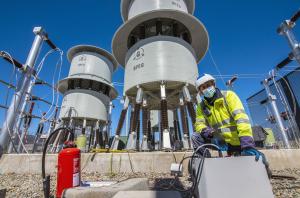High voltage, high risk
In the southern part of the construction platform, a one-hectare yard hosts some of the strangest-looking components of the entire ITER installation. Rows of tower-like cylindrical structures stand 8 metres tall; other oddly shaped devices line up like soldiers in a frozen parade. This vast area is the realm of reactive power compensation and harmonic filtering—characterized by a dense arrangement of thyristor-controlled valves, reactors, capacitors, resistors and sensors that aim to smooth the flow of AC current and eliminate harmonics, both inside the ITER installation and in the immediate vicinity.
Procured by China, the equipment is now almost completely installed. After factory acceptance tests at the manufacturer's facility, a new set of on-site tests was launched in early March. "Basically, we are following the same strict procedure as the factory acceptance tests. Everyone needs to make sure that we still have a no-default situation despite the long journey from China and subsequent handling on site," explains Massimiliano Camuri, the electrical engineer in charge of verifying the integrity of the components.
What is at stake is both functionality and safety. Most of the installed equipment is high voltage, which means a high risk of electrical arcs in case of defective insulation. All in all, the inspection test plans defined by the Chinese manufacturer Rongxin Power Electronic Co. Ltd comprise close to 2,000 individual tests, half of them qualifying as "high voltage/high risk."
In order to be tested, the equipment must be energized first. This is done by connecting the component to a control box the size of a small suitcase, whose twin transformers elevate the standard voltage (230 V) to 112 kV. "The operational voltage will be in the range of 66 kV, but we have to take some phenomena, like switching overvoltage, into consideration. Testing at 112 kV gives us a comfortable safety margin," says Massimiliano.
The first equipment to be tested is the 8-metre-tall thyristor-controlled reactors, whose function is to compensate the reactive power.
As Massimiliano, protected by fire-resistant work wear, headpiece and face shield slowly turns the knob that elevates the voltage, the hum of electrical current, like the buzzing of a thousand bees, fills the air. The test lasts one minute and aims to check the integrity of the massive ceramic insulators that are integrated in the tall towers. The test is conducted in compliance with all electrical safety rules—the most important being the rule of equal-potentiality, which means that all metallic parts must be connected to ground. The dials on control box are of course essential to monitoring the stability of the current. But electrical engineers also rely on their trained ears. "There are noises that are 'normal' and some that aren't," says Massimiliano. "You've got to listen carefully to tell the difference."
All the while, at a safe distance, two engineers from Rongxin Power Electronic Co. Ltd observe the operation. A representative of SAET, the Italian company responsible for the installation, is also present to provide support.
The minute is now over and the hum has stopped. Another thyristor-controlled reactor has passed the test. More are waiting ... enough to keep Massimiliano and his team busy until mid-June.


